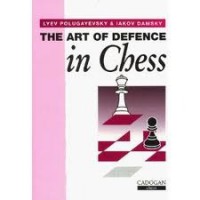Art of Defence in Chess: Defence and Counterattack Techniques in Chess
 Before going into a review of the classic work by GM Polugayevsky and IM Damsky, let me explain my own chess credentials, and what level of players I feel this book would be most beneficial for.
Before going into a review of the classic work by GM Polugayevsky and IM Damsky, let me explain my own chess credentials, and what level of players I feel this book would be most beneficial for. My USCF rating is 2029, expert/candidate master, and as a young teen, I was one of the top 15 players in the US for my age. That being said, I consider myself too weak to get anything from the chess series written by Dvoretsky and Yusupov, so it's very important to realize the proper audience for a tome.
I read "The Art of Defence in Chess" when I was 11 years old, and played at a 1300-1400 level. That is, I was an avid junior tournament player who studied and played very regularly, for a few hours every day. For anyone beneath that strength, I don't see much purpose to reading "The Art of Defence in Chess"; the tactics alone are too complicated.
That being said, "The Art of Defence in Chess" is a terrific masterpiece that will aid players from 1300 all the way up to national master (2200).
As the title states, it concentrates on what to do when a player finds himself under a vicious attack from the enemy forces. The examples of attacks range from relatively innocent-looking positions to ones where you would swear the defending side has no way to avoid being crushed!
There are a wide variety of types of defense discussed, all split up into their own chapters. There is "passive defense", "counterattack on the kingside", "counterattack on the queenside", "the Exchange Sacrifice", "counterattack in the center", "exchanging off the pieces, and taking endgame refuge", and several others.
In each case, we see how employing that type of defense has allowed players to draw or even win against the most skillful and tenacious of attackers.
Each illustrative position for each theme is highly diverse, and primarily drawn from high-level GM games from the 1950s to the 1980s. Thus, there's no risk of seeing pawn structures and types of positions incompatible with modern openings.
Also, GM Polugavesky and IM Damsky do a great job providing analysis for each positional example, going through all the relevant lines and variations for each move. They never overwhelm the reader, and keep the main defensive idea clear at all times.
Lastly, at the end of each chapter, we're presented with problems for the reader to solve. Each of them is chosen well, and is a specific test of the themes discussed in the chapter.
Ultimately, a book like this is determined by its results.
In my case, it completely changed my outlook on chess and entire tournament career.
Thanks in part to this book, I went from being a decent junior to one of the best juniors for my age in the country, and a junior high state champion less than two years later.
Specifically, I used to hate defending before this book, and was not very good at it.
Nowadays, I absolutely love defending, and it is my single biggest strength as a player. While I have a hard time winning games, I also very rarely lose; the techniques in this book have helped me hold the draw many, many times in critical tournament games, even against masters.
As such, I have to applaud the book as a true masterpiece. It tackles a subject that deserves more attention in chess literature, defense, and doing it in a thrilling, exciting, but most importantly, effective manner!


